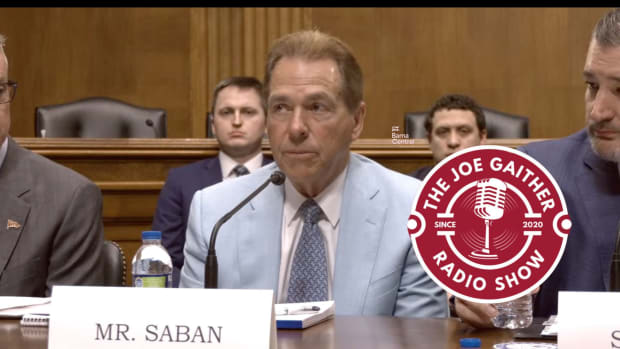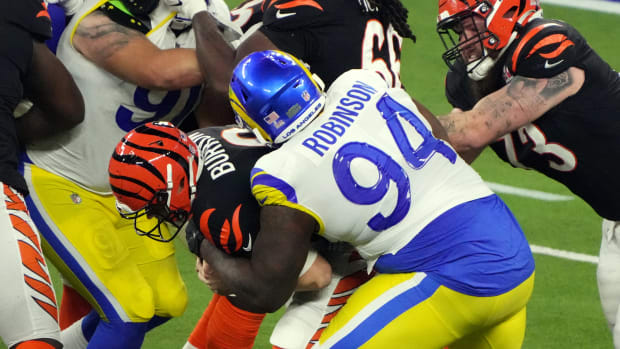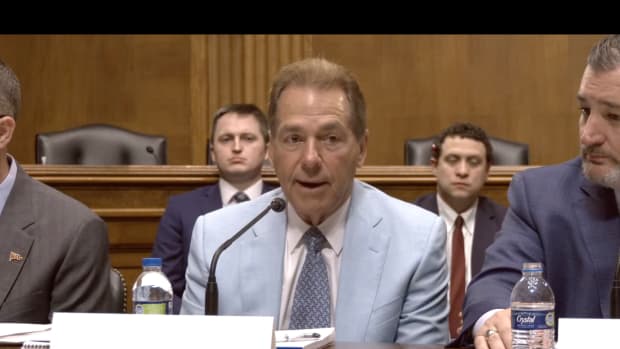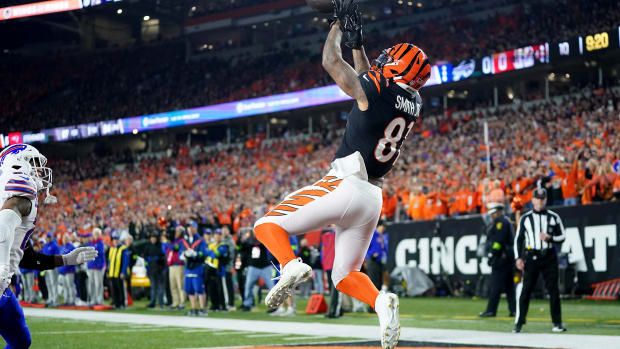When it comes to the NFL draft, Alabama's flying aces could really be in rare air
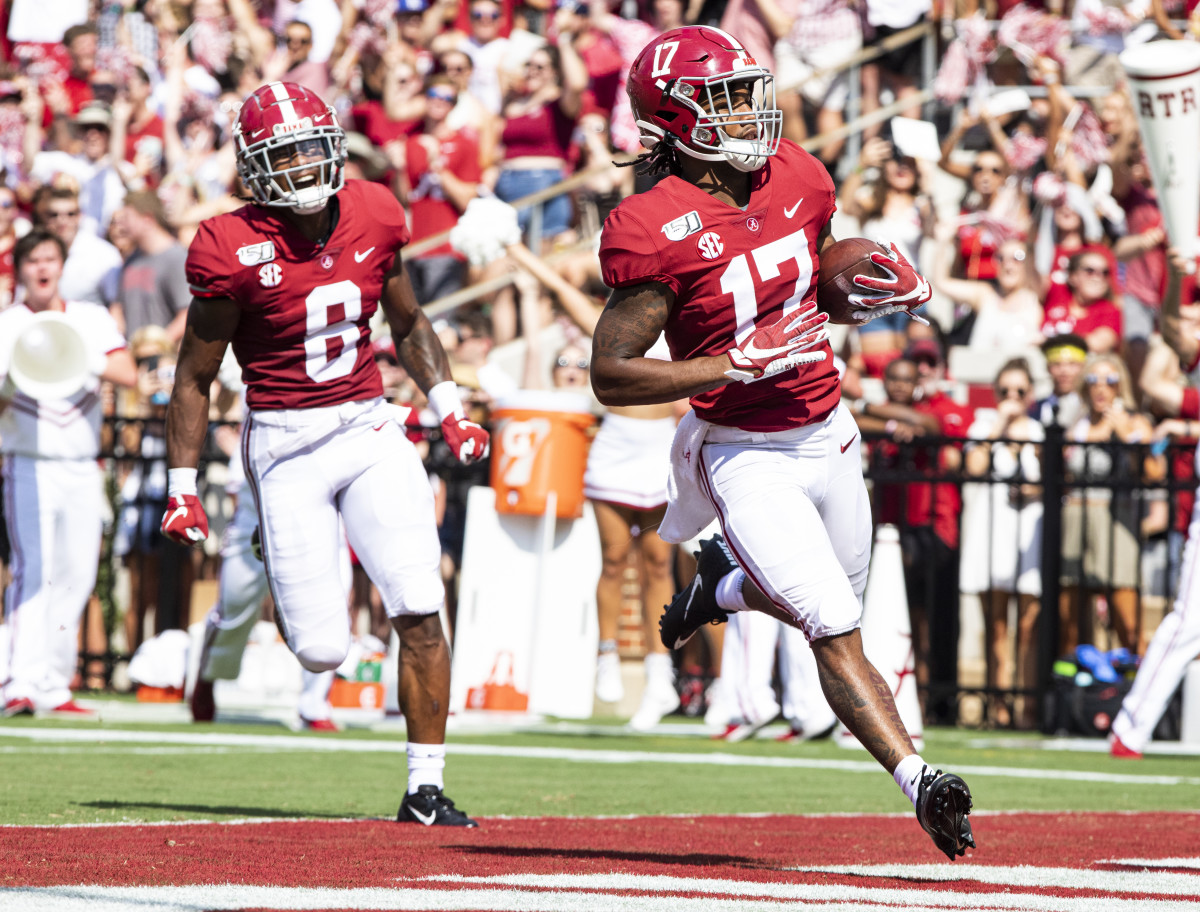
TUSCALOOSA, Ala. — Wide receiver Jaylen Waddle knows that his chance will come, maybe even this Saturday when Alabama visits his home state and plays Texas A&M.
It did last year, and he’s come oh-so-close to notching his first touchdown of the 2019 season, including more than one that was nullified by a penalty. But that’s the thing. Even when opposing defenses have been able to stifle or slow one of Alabama’s prolific wide receivers, they’ve gotten burned by another.
Just ask DeVonta Smith. After being overlooked by most preseason publications for All-SEC and All-American honors he had 274 receiving yards and five touchdown catches against Ole Miss, both Crimson Tide records.
“It’s fun,” Smith said about playing with such dynamic teammates. “I think it’s a challenge, I think we feed off each other and make each other better. I love it.”
Trying to put this group’s ability and prowess into perspective is difficult because the game has changed so much over the years and there have been so few examples of four outstanding talents playing together on one position group.
At least at running back college football has had the Heisman Trophy backfield of Army’s Doc Blanchard (1945) and Glenn Davis (1946), and of course the Four Horsemen at Notre Dame of Harry Stuhldreher, Don Miller, Jim Crowley, and Elmer Layden.
They call themselves the "Ryde Outs," but the way these guys are going they might need flying handles as well. Fighters often use a finger-four formation that when viewed from above resemble the tips of the four fingers of a human right hand (without the thumb).
“Very rarely do you see four guys who can score the ball at any time,” Texas A&M coach Jimbo Fisher said. “They can go deep, short. Their double moves are phenomenal and how they run routes and the system in which they have and how they run, it’s a very good, disciplined group.
“This group knows how to run routes and how to get open. They create a lot of separation.”
As for just how unique they are as a position group the debate will go on for a long, long time. All four have already topped 1,000 career receiving yards, something that had never been done before at Alabama (having four all playing at the same time).
But yards can only tell so much about a receiver, especially at the collegiate level. Most fans couldn’t name the only two players in college football history to top 5,000 career receiving yards, Corey Davis of Western Michigan (now of the Tennessee Titans) and Trevor Insley at Nevada.
Scheme can dictate a lot. The first team to have three wide receivers top 1,000 yards together in a single season was Texas Tech in 2003, but chances you’ve only heard of one of them: Carlos Francis (1,117 yards), Wes Welker (1,099 yards) and Nehemiah Glover (1,081 yards).
Welker had a sterling NFL career while Francis was the only one of the three to be drafted, in the fourth round to the Oakland Raiders. He had the unique statistic of having a lost fumble despite never making a reception in the league, and was released in 2007.
Nevertheless, the draft does offer an interesting point of reference.
Jeudy and Ruggs are already being touted as potential first-round selections, with Smith and Waddle certain to be high picks as well. In comparison, Alabama has had three first-round picks at the position during the Nick Saban area, but they’ve been scattered throughout the past decade with Julio Jones in 2011, Amari Cooper in 2015 and Calvin Ridley in 2018.
Not too many programs in college football have had four wide receivers drafted within a year of each other.
Just among schools beginning with the letter “A” …
In 1976-77, Arizona had Scott Piper, Theo Bell, Keith Hartwig and Charles Nash all selected, but two were in the 11 round.
In 1981, Arizona State had three wide receivers taken, and all in the first six rounds with John Mistler, Ron Washington and Mel Hoover. It also had the same thing occur in 1969 with Larry Walton, Fair Hooker and Rick Shaw, a year after Ken Dyer was drafted.
In 2012, Arkansas had three, all in the first four rounds, with Joe Adams, Jarius Wright and Greg Childs, followed by Cobi Hamilton in the sixth round a year later.
Alabama has had three wide receivers taken over three years, in 2002-04 with Jason McAddley, Freddy Milons and Triandos Luke, but the more interesting aspect with those selections were the teams involved with the latter two, the Eagles and Broncos, respectively. Neither has drafted an Alabama player since, making them the Crimson Tide’s longest draft droughts.
The list of top receiving groups via the draft gets very short when requiring that all four were selected in the first seven rounds — which has been the length of the draft since 1993 — and at least one being a first-round pick (tight ends not included).
Alabama’s never done that, but Saban helped develop a group that did at LSU.
Josh Reed, Michael Clayton and Devery Henderson all went in the first two rounds between 2002-04. The second wave led to Dwayne Bowe and Craig Davis being first-round selections in 2007, with Skylar Green and Bennie Brazell went in the fourth and seventh rounds in 2006, respectively.
“They’re all different,” said Saban, “but they were all very good players. They were all hard workers and very productive.
“This group that we have now is extremely talented, they work hard, they’re not selfish. They all have shown an ability to make explosive plays, which I think is probably important to the success of our team.”
Also on the short list:
Florida
The Gators had waves of receivers during the Steve Spurrier era, but one group in particular might have been the closest thing to what Alabama has now. Ike Hilliard and Reidel Anthony were first-round picks in 1997, followed by Jacquez Green in the second round in 1998 and Travis McGriff a third-round selection in 1999.
Technically they’re a near-miss as the four were drafted over three years, but when they played together during the 1996 season, with Danny Wuerffel finishing with 3,625 yards and winning the Heisman Trophy, Anthony had 72 catches for 1,2983 yards, Hilliard 47 for 900, Green 33 for 626 and McGriff 14 for 167. More importantly, it was the year Spurrier won his lone national championship.
Florida State
The Seminoles had first-round selection Peter Warrick and third-round selections Ron Dugans and Laveranues Coles in 2000, plus Marvin Minnis was a third-round pick in 2001. The following year Javon Walker was a first-round pick by the Green Bay Packers. Bobby Bowden won the national championship in 1999 and quarterback Chris Weinke the Heisman Trophy in 2000.
Miami
In 2001, the Hurricanes had Santana Moss and Reggie Wayne selected in the first round, with Andre King in the seventh. Daryl Jones also went in the seventh round in 2002, plus a year later Andre Johnson was the third-over pick. Miami won the national title in 2001. Incidentally, it had had three wide receivers go in a single draft in 1968, 1988 (Michael Irvin was a first-round pick), 1991 (Randal Hill) and 1993.
Ohio State
In 2006-07, the Buckeyes had Santonio Holmes, Ted Ginn Jr., Anthony Gonzalez all be first-round selections, and Roy Hall was a fifth-round pick. The 2005 Buckeyes didn’t have a 1,000-yard receiver and finished 10-2 due to first-half season losses to No. 2 Texas and at No. 16 Penn State. They finished No. 4 in the final AP Top 25. The quarterback? Troy Smith, who won the Heisman Trophy in 2006.
Oklahoma
In 2005, Mark Clayton was a first-round selection, followed by Mark Bradley in the second round and Brandon Jones in the third. A year later, Travis Wilson was a third-round pick. The 2004 Sooners, who also boasted running back Adrian Peterson, didn’t have a 1,000-yard receiver, but ran the table until losing the national title game to USC in the Orange Bowl. Quarterback Jason White won the Heisman Trophy in 2003.
Southern California
In 1999, USC saw Larry Parker taken in the fourth round and Billy Miller in the seventh. The subsequent draft included R. Jay Soward in the first round and Windrell Hayes in the fifth.
Tennessee
The Volunteers have sort of done it twice. In 1983, Tennessee had Willie Gault selected in the first round, Darryal Wilson in the second and Mike Miller in the fourth. A year later Clyde Duncan went in the first round with Lenny Taylor in the 12. Before them, Anthony Hancock was a first-round pick in 1982. Amazingly, the four finished the 1982 season with just 1,403 combined receiving yards, 668 by Gault, as UT finished 6-5-1.
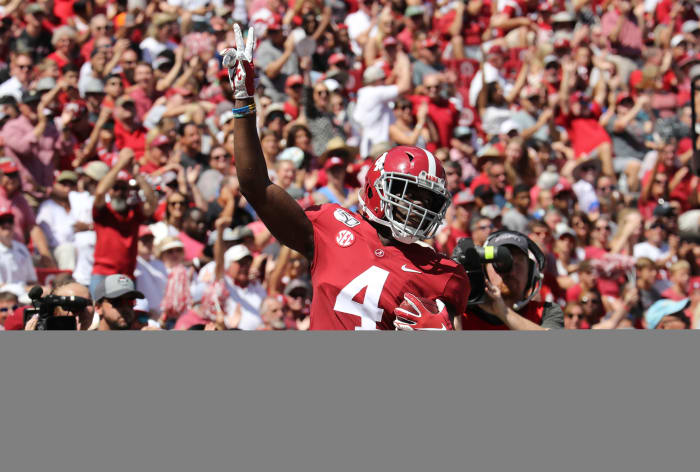
Jerry Juedy is trying to become just the third player to win the Biletnikoff Award twice.
Courtesy Alabama Athletics
In 1991, Alvin Harper was a first-round pick, followed by Anthony Morgan in the fifth round and Vince Moore in the 11. A year later Carl Pickens was a second-round selection and like Harper went on to have a prolific NFL career.
Finally, out of all the players mentioned in the story, only three won the Biletnikoff Award as the best receiver in college football. Two were in passing reference, Cooper and Reed. The other was Jeudy.
That’s how unique this is.


